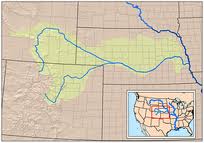Connection in Nature: Don’t Break the Link
A symbiotic relationship exists between cranes and the Platte River. While on migration, cranes gorge themselves on waste leftover from grain harvests along the Platte. In order to build up fat reserves, they must increase their body weight by ten percent. During this rest and feast time in the midwest, cranes also require a safe habitat in which to roost. Shallow sandbars surrounded by acres of flat fields, makes it difficult for predators to go undetected by the birds. But the Platte River depends upon the cranes for its survival as well.
|
Wikipedia image
|
Snowmelt from the Rocky Mountains cascades down mountain gorges forming the North and South Platte Rivers. The two converge in western Nebraska becoming the Platte as it spreads over plains, bisecting the state and creating a nutrient-rich soil for growing grain. With no steep banks to contain it, the river is wide, shallow, and muddy. But, like the cranes, it is also threatened. With eleven damns along the North Platte and the more than thirty along the streams in Colorado and Wyoming, the flow of the Platte has been reduced by nearly eighty percent. With the shrinking of the river, comes the vast reduction of crane habitat. In order to save the integrity of the river so that the crane population would not dwindle, The Platte River Whooping Crane Trust was established in 1979. The trust’s mission was to protect and maintain the viability of its lands for migratory birds. By protecting the birds, the Trust is also protecting the river.
For additional information on cranes and the Platte River, read The Cry of the Sandhill Crane by Steve Grooms, NorthWord Press, Inc.


